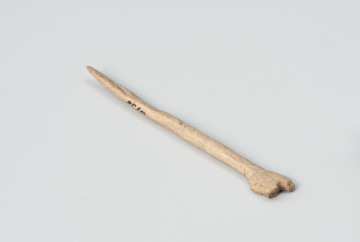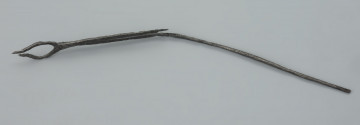
Bone pin for fastening hair or robes
800 — 1200
National Museum in Szczecin
Part of the collection: Middle Ages
Leather pouches used for carrying and storing handy everyday, household and craft items were attached to belts or carried on cord strings hung around the neck. They were also used to protect the user from injury while carrying sharp utensils and tools such as knives, scissors, pins and awls. People of all genders and ages used them, and their function was primarily utilitarian. Their simple construction - a piece of leather folded in half - required no special skills. The method of decoration was a very different affair, depending not only on the user's taste, but also on his or her manual skills and abilities, as well as technical capacity. The pouch was a prominent element of the attire, so its design was important as it said a lot about the financial and social status of the owner. Early medieval leather pouches were decorated in many ways. Among the simplest is the decorative stitching of the edges using, for example, coloured woollen thread, a thin leather cord or, much less frequently, metal wire. Their surfaces were very often decorated with embroidered geometric and floral motifs. More elaborate techniques also came into use, including the embossing and imprinting of various designs, some of which had symbolic significance. Slavic circles typically ornamented their objects with metal fittings made of nonferrous metal alloys, most frequently copper, which also reinforced the design and durability of the pouches. The pieces included various shaped thin plates with decoratively punched or engraved surfaces, which were placed in the most vulnerable areas - the lower and upper parts of the pouches. They were attached to the leather base by rivets on pads, that sometimes were also of incredibly decorative value. The selection of ornamental motifs on the fittings was a combination of several factors, including the maker's competence and sense of beauty, as well as local patterns and sometimes symbolic meanings that are difficult to read today. Undoubtedly, some of the most striking and intriguing fittings are those occurring most rarely, including triangular ones resembling dragon heads. Anna Bogumiła Kowalska
Author / creator
Object type
costium adorment, fitting, scabbard
Technique
tapping, punching
Material
metal alloy
Origin / acquisition method
field research
Creation time / dating
Creation / finding place
Owner
Muzeum Narodowe w Szczecinie
Identification number
Location / status

800 — 1200
National Museum in Szczecin

około 1500 p.n.e. — 1300 p.n.e.
National Museum in Szczecin

476 — 1250
National Museum in Szczecin
DISCOVER this TOPIC
Museum of King Jan III's Palace at Wilanów
DISCOVER this PATH
Educational path